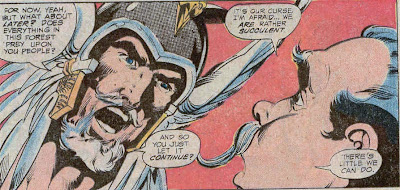Most role-playing games that run more than one book prove a catalog of monsters. D&D in its various incarnations provides us with more than one. I would suspect most gamemasters are like myself and have never employed
every monster in any of those books, much less all of them. I wonder, though, how people decide which monsters to play versus which to leave on the bench?
In my oft-revised, ever-evolving
D&D to
GURPS to
Wizards & Warlocks setting (now answering to the named The World of
Arn), I first employed whatever monsters struck my fancy from the three
AD&D monster manuals and various issues of
Dragon. I had the vague notion that any monster was fair game, but some spoke to me more than others--and some were just lame.
Later, when the world took a Sword & Sorcery turn, under the heady influence of Leiber and Howard, actually monsters (except humanoids) became rarer--human foes were the order of the day, and various prehistoric animals (the setting being in a mythic prehistory in good Howardian fashion) in wilderness adventures. Later, I wanted my own "signature" monsters (like Tolkien had his orcs) so I played up obscure entries from
Dragon over standards. Why have the same old orcs when you can have cynamolgi (from
Dragon #141 for you completists)? I mean, even the cartoon set itself apart from the norm by pushing bullywugs to prominence.
The latest iteration brought me full circle in a way, with all the glorious, crazy, D&D creatures stalking the world, albeit perhaps in a more “rationalized” fashion. And still some of the dregs got ignored. (Sorry
flumph.)
The world of the City presented a challenge of adaptation. Here, I’ve been more planful about what monsters I’m gong to use. They have to be able to “work” with the more modern setting, and I really want to have in mind what the beastie's roll is in the setting--even if that’s just “monster of the week.”
So how do you decide what monsters are in your setting, be it D&D or otherwise? Grand plan? Whimsy?
























